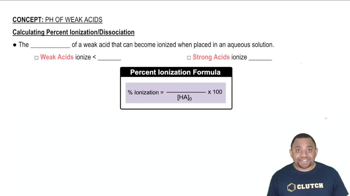Textbook Question
(a) Calculate the percent ionization of 0.0075 M butanoic acid 1Ka = 1.5 * 10-52.
 Verified step by step guidance
Verified step by step guidance



(a) Calculate the percent ionization of 0.0075 M butanoic acid 1Ka = 1.5 * 10-52.
(b) Calculate the percent ionization of 0.0075 M butanoic acid in a solution containing 0.085 M sodium butanoate.
(a) Calculate the percent ionization of 0.125 M lactic acid (Ka = 1.4 × 10-4).
Which of the following solutions is a buffer? (a) A solution made by mixing 100 mL of 0.100 M CH3COOH and 50 mL of 0.100 M NaOH, (b) a solution made by mixing 100 mL of 0.100 M CH3COOH and 500 mL of 0.100 M NaOH, (c) A solution made by mixing 100 mL of 0.100 M CH3COOH and 50 mL of 0.100 M HCl, (d) A solution made by mixing 100 mL of 0.100 M CH3COOK and 50 mL of 0.100 M KCl.
(a) Calculate the pH of a buffer that is 0.12 M in lactic acid and 0.11 M in sodium lactate.